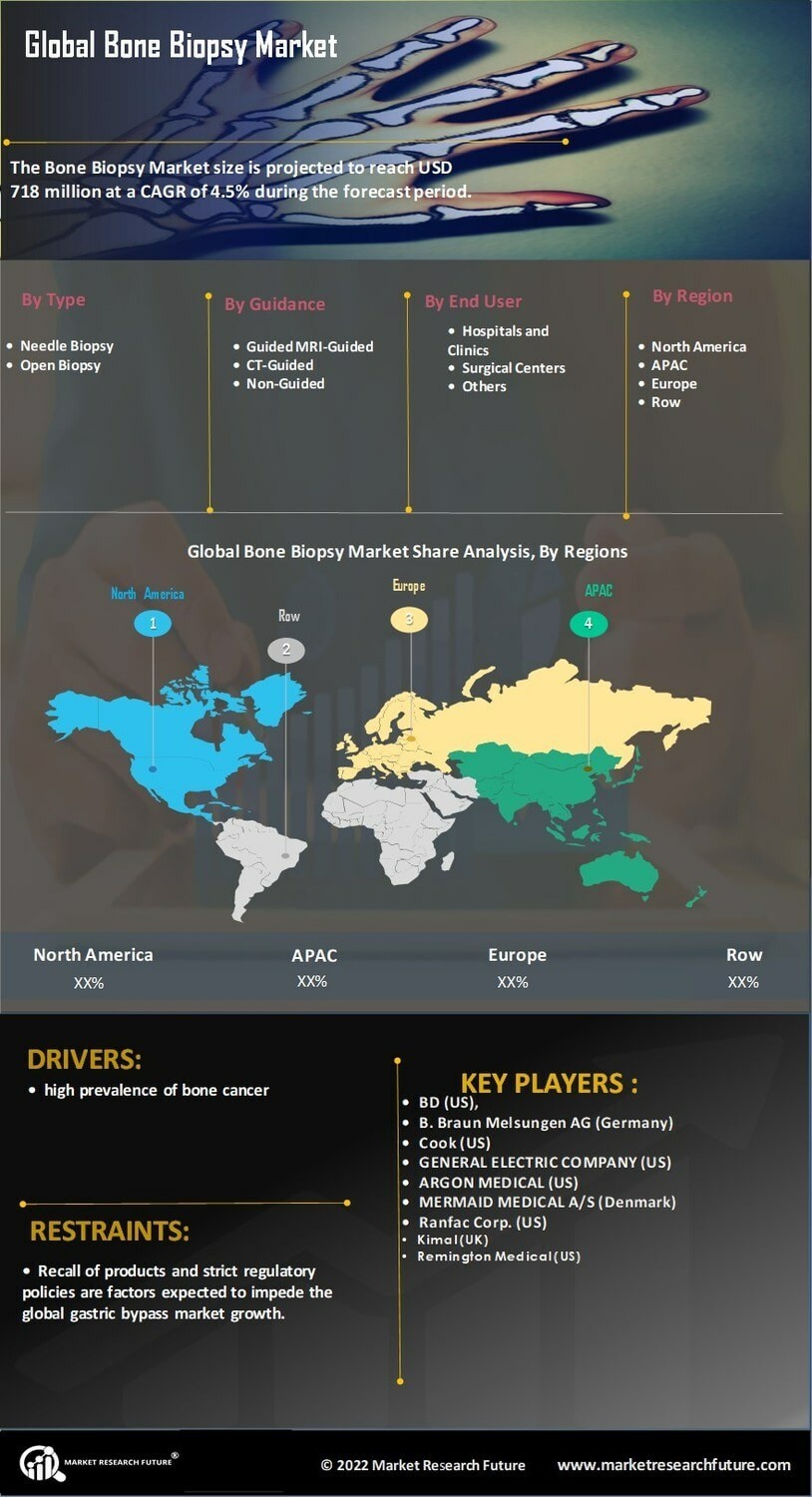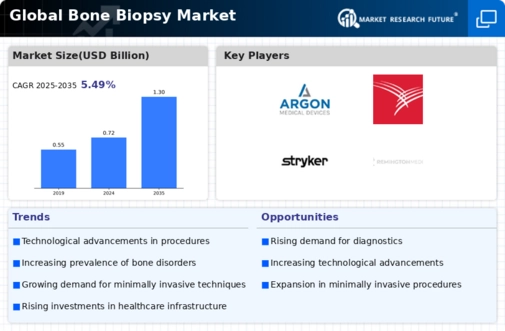DRIVERS
Growing demand for minimally invasive procedures
Growing demand for minimally invasive procedures is fuelling the growth of the global bone biopsy market. A minimally invasive procedure is the use of a variety of techniques to operate with less damage to the patient’s body. It has various benefits, such as fewer operative and post-operative major complications, less post-operative pain, shortened hospital stays, and faster recovery times. According to the WHO, in 2019, it was reported that around 235 million major surgeries are conducted every year across the globe.
Bone biopsy is a minimally invasive procedure that becomes the initial procedure of choice in most cases for obtaining bone samples. It offers multiple advantages over open surgical biopsy, including minimal soft tissue injury, maintenance of a bone structure, and a reduced need for general anesthesia. This results in an increasing preference for minimally invasive procedures by patients. This is driving the global bone biopsy market
Increasing acceptance of bone marrow biopsy for diagnosis and treatment of lymphoma and leukemia disease
Restraints
Stringent regulatory policies
The stringent regulatory policies for manufacturing and distributing medical devices in various regions are hampering the growth of the global bone biopsy market. For instance, the US Food & Drug Administration (FDA)’s Center for Devices and Radiological Health (CDRH) regulates the manufacturing, repackaging, relabelling, and/or importing of medical devices sold in the US. The basic regulatory requirements that manufacturers of medical devices distributed in the U.S. must comply with are established registration, medical device listing, premarket notification 510 (k), quality system regulations, medical device reporting, and others.
Both domestic and foreign manufacturers of medical devices must register their establishments with the FDA. This is a restraining factor for the players involved in the global bone biopsy market.
Opportunities
Improving healthcare infrastructure across emerging countries
Improving healthcare infrastructure across emerging countries is creating opportunities for the players involved in the bone biopsy market. The growth of the healthcare infrastructure enhances the development of advanced products for bone biopsy procedures. The players involved in the healthcare sector across emerging countries are heavily investing in technologies. For instance, in May 2022, Terumo India, the Indian arm of Terumo Corporation, signed a partnership agreement with US-based Argon Medical, the market leader in specialty medical products, including guide wires, IVC filters & retrievals, bone & soft tissue biopsy needles, and other products in India.
It will help Terumo to offer advanced medical solutions. The geriatric population is increasing in emerging countries such as China and India. For instance, according to WHO, in 2019, there were 254 million older people aged 60 and over, and 176 million older people aged 65 and over in China. Geriatric people are more susceptible to chronic diseases such as cancer, which is also fuelling the demand for advanced bone biopsy products in the region.
Value Chain Analysis
The global bone biopsy market is showing positive movements in growth owing to the increasing cases of blood and marrow diseases and growing incidences of bone cancer across the globe. The value chain analysis for the market comprises four major components, which start with the R&D designing, manufacturing, distribution & sales, and post-sales review.
Bone biopsy needles and other products related to bone biopsy require extensive research and development to obtain accurate results. The scientific research and development of advanced and effective biopsy products have excelled in diagnosing bone marrow-related diseases among individuals. These products require years of investigation and product testing to get an efficient and accurate portfolio. R&D and designing of such products are focused on expanding their product range of new needles aimed at improving surgical procedures. In this process, the product strategies are ready, and the manufacturing process of the product commences.
The manufacturing process begins with the assembling of raw materials and production of needles, and other products in-house or through third-party manufacturers. Distribution & sales is an essential part of any industry. The revenue of the bone biopsy market majorly depends on distribution and sales. This market consists of distribution & sales, which further includes intermediaries, direct selling, and others. A robust distribution network, strong customer base, and effective sales team drive the sales of bone biopsy consumables.
As products in the market are developed for testing bone marrow problems, the development of abnormal cells and other bone problems are reviewed by government agencies, and their functions are monitored closely to minimize any side effects among the users. The products are also monitored to enhance the current functioning and eliminate the existing problems related to the side effects and other minor glitches.
The increasing prevalence of bone-related diseases and advancements in biopsy techniques are driving a notable transformation in the bone biopsy market, suggesting a shift towards more precise and less invasive diagnostic procedures.
U.S. National Institutes of Health (NIH)














